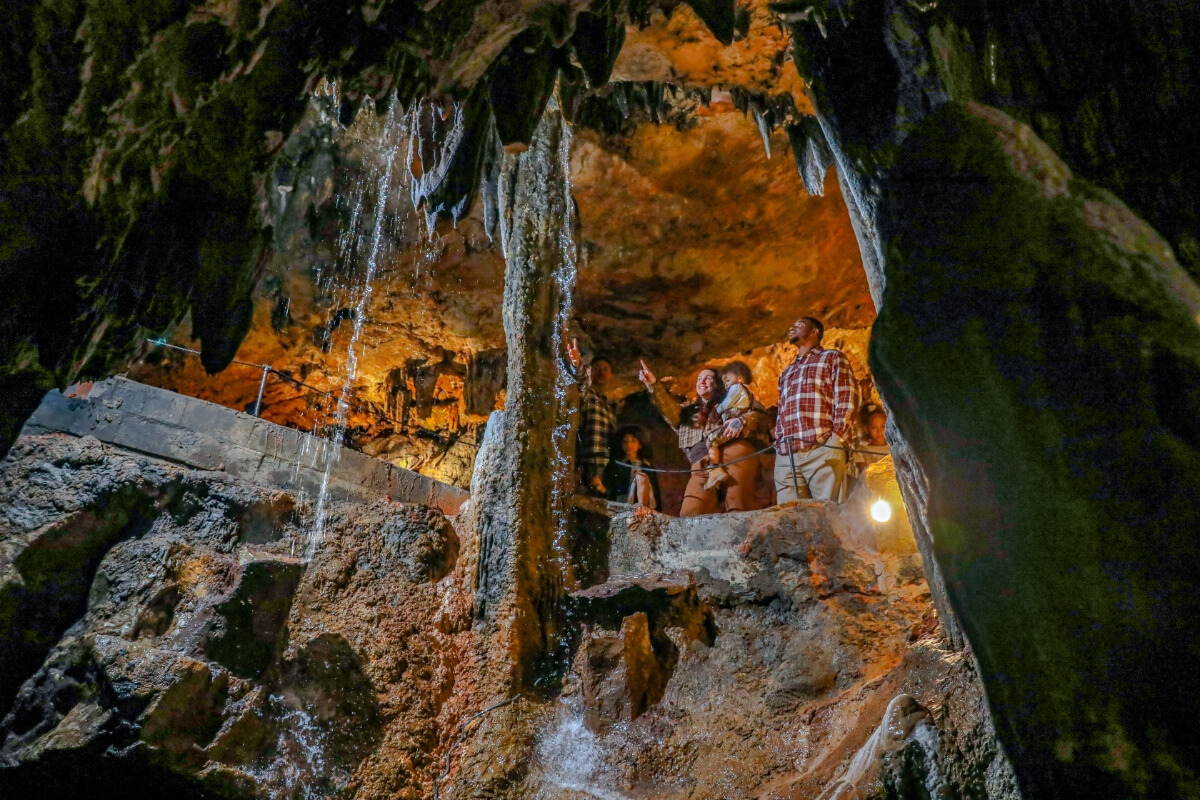These caves in Alabama are underground wonders that tell stories of prehistoric life, hidden gemstones, and even Prohibition-era secrets. Whether you’re exploring a mile-long cavern, spotting thousands of bats at dusk, or uncovering artifacts from early civilizations, these destinations promise unforgettable experiences.
MAJESTIC CAVERNS | CHILDERSBURG
Previously known as DeSoto Caverns, Majestic Caverns in Childersburg is one of the most historic caverns in the United States. With a human history spanning over 2,000 years, it attracts thousands of visitors every year for its natural formations that are as rich and breathtaking as its storied past.
Native Americans from the Woodland Indian Period used the caverns for shelter, burials, and healing. Hernando de Soto explored them in 1540, and one of George Washington’s right-hand men recorded them as America’s first documented cave. Later, Ida Mathis mined gemstone-quality onyx, and during Prohibition, the caverns briefly operated as a moonshine speakeasy!

An hour from Birmingham, Majestic Caverns is located in the Appalachian Mountains and stays at 60 degrees year-round, making it a perfect stop for hot or rainy days. On every guided tour, guests can catch a beautiful laser light show while hearing about and seeing the unique earth sciences taking place right under the surface.
There is a cafe and over twenty unique attractions above the cave designed for all ages and thrill seekers, from inflatable archery to authentic gemstone panning. You can extend the adventuring by staying on the tranquil campgrounds, complete with picnic areas, fiber wireless internet, and a pavilion with full bath and washing amenities.

CATHEDRAL CAVERNS STATE PARK | WOODVILLE
Nestled near Huntsville and Scottsboro, Cathedral Caverns State Park showcases one of Alabama’s most stunning natural wonders. Originally called Bat Cave, it was opened to the public in the 1950s and renamed for its cathedral-like appearance.
The most striking feature of Cathedral Caverns is its massive entrance, measuring an impressive 126 feet wide and 25 feet high — one of the largest commercial cave openings in the world! Inside, visitors will find awe-inspiring formations, including “Goliath,” one of the world’s largest stalagmites at 45 feet tall and 243 feet in circumference, a “caveman” figure atop a flowstone wall, a frozen waterfall, and an astonishingly thin 27-foot-tall stalagmite measuring only three inches wide.
Beyond the cave, the 493-acre park offers hiking trails, gemstone mining, picnic pavilions, and camping options, including improved sites, primitive tent areas, and backcountry camping.
RUSSELL CAVE NATIONAL MONUMENT | BRIDGEPORT
Tucked away in northeastern Alabama near Bridgeport, Russell Cave National Monument offers a glimpse into over 10,000 years of human history. Used as a seasonal shelter from 6500 BCE to 1650 CE, the cave provided food, tools, and warmth for prehistoric peoples.
Excavations in the 1950s uncovered thousands of artifacts, making it one of the most complete records of early cultures in the Southeast. Established as Alabama’s first national monument in 1961 and listed on the National Register of Historic Places in 1966, the site is now managed by the National Park Service.
While cave entry is not permitted, visitors can stroll the boardwalk leading to its massive entrance, view artifacts in the Visitor Center Museum, or hike the 1.2-mile nature trail to experience the landscape once inhabited by early people. Russell Cave is also a stop on the North Alabama Birding Trail and features a Birds of Prey program. Families can enjoy a picnic area, and young visitors can work their way through fun activities to earn a Junior Ranger badge.
RICKWOOD CAVERNS STATE PARK | WARRIOR
A short drive from Birmingham, Rickwood Caverns State Park is home to a cave with 260-million-year-old formations, carved from an ancient ocean bed. The cave maintains a cool 58 to 62 degrees — a refreshing escape as you explore 175 feet underground! Guided tours of the mile-long caverns are available year-round.
Walk the park’s Fossil Mountain Hiking Trail, where leaf and seashell impressions in the rocks showcase the area’s prehistoric past. Families can enjoy gemstone mining, a playground, and picnicking areas, while campers can settle in for an overnight stay. For a refreshing dip, the park features an Olympic-size swimming pool — fed by the cave’s cool, crystal-clear waters — and a kiddie pool for younger visitors.
ALABAMA BAT CAVES | VARIOUS LOCATIONS
While you won’t find the Batmobile, wildlife enthusiasts will be amazed by the natural spectacle of bats emerging from these caves. Also known as the Bat Cave on Lake Guntersville, Hambrick Cave is a TVA-managed site on the Tennessee River, about a mile upriver from Guntersville Dam. Home to one of the largest gray bat maternity colonies, it hosts evening emergences of over 60,000 bats. Viewing is by boat only, and shining lights on the bats is prohibited.
Located off Highway 72, about seven miles west of Scottsboro, Sauta Cave shelters over 250,000 gray bats. From May to September, mid-summer offers the most spectacular dusk emergences, lasting 30 to 40 minutes. Visitors can watch from an observation deck but cannot enter the cave. For reasons we hope are obvious, wearing a cap or bringing an umbrella is recommended.
Part of Wheeler National Wildlife Refuge, Cave Springs Cave is another vital gray bat habitat, with summer emergences exceeding 40,000 bats. While entry is not permitted, visitors can watch the bats from the cave entrance.
**********
Looking for even more adventure? Discover StyleBlueprint’s outdoor travel inspiration HERE.



















